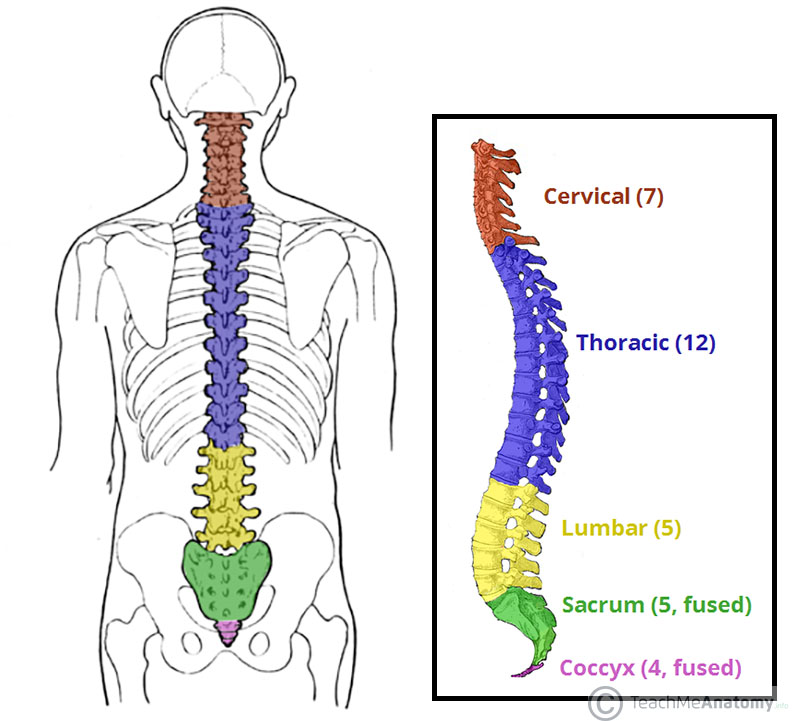WHAT’s THE PARTS OF THE SPINE?
S
What’s the Spine?
The spine, also known as the vertebral column, refers to the flexible structure running from the neck down to the lower back that functions as the body’s central support structure. The spinal column encompasses the bones, muscles, tendons, and other tissues that travel from the base of the skull to the lower back. The spine, although flexible, serves to connect the different parts of the skeleton and plays a major role in keeping the body upright. Situated within the spinal column lies the spinal cord which refers to a network of tissues, nerves, and cells that functions as a messaging center between the brain and the rest of the body.
A healthy human spine possesses four slight curves that give it a characteristic S shape. These curves occur in the cervical (neck), thoracic (upper back), lumbar (lower back), and sacral (bottom of the spine), regions of the spine. The S-shaped curve of the spine serves to stabilize and maintain the structure of the spine. It also helps protect the individual bones in the spine from fracture by acting as a shock absorber when walking.
What’s the Parts of the Spine?
The human spine consists mainly of the vertebrae, spinal cord and nerve roots, intervertebral discs, facet joints, and soft tissues.
Vertebrae
The vertebrae consist of 33 individual bones stacked together to form the spinal or vertebral column. These bones interlock with each other to form building blocks for the spinal column. The spinal column houses the spinal cord and bears the majority of the weight put upon the spine. The vertebrae get their Names according to their region of the spine. These regions include the cervical, thoracic, lumbar, sacrum, and coccyx regions.
Spinal cord and nerve roots
The spinal canal refers to an 18 inches long network of nerve fibers that run through the spinal column. A protective covering called the dura mater encloses the spinal cord and a spinal fluid inside the column. The nerve fibers in the spinal cord branch off going down the spine to exit through spaces between the vertebrae. These bundles of nerve fibers that branch off connect to specific parts of the body to control and coordinate that specific region. This explains why certain neurological issues caused by damage to the spinal cord may affect specific parts of the body and not the others.
The spinal nerves also transmit electrical signals and sensory information from the brain to skeletal muscles and internal organs through the spinal cord and vice versa. The spinal cord, together with the brain forms the central nervous system.
Intervertebral discs
The intervertebral discs refer to a number of flat, round cushions with a solid, multi-layered casing of cartilage fiber and a gel-like core. These discs which sit between the vertebral bones take on the responsibility of keeping the bones from rubbing together. The intervertebral discs help keep the spine flexible while acting simultaneously as the spine’s shock absorbers. The spinal discs contain a gel-like fluid that gets released when the spine experiences pressure. The discs reabsorb this fluid when the spine gets relieved. Since the spine constantly undergoes pressure, this process occurs continuously throughout life. As individuals age, the discs lose the ability to reabsorb fluid and in turn, get brittle and flatter. Diseases such as osteoporosis and osteoarthritis tend to occur with old age due to brittle intervertebral discs. A herniated disc may also occur due to damage to the intervertebral discs.
Facet joints
The facet joints of the vertebral column contain cartilage that allows the vertebral bones to slide smoothly against each other. These joints include two superior and two inferior facet joints to connect vertebral bones above and below. The facet joints of the spine help permit back motion of the spine and provide flexibility and stability to the spinal column. Facet joints, when damaged, can develop arthritis and cause back or neck pain.
The soft tissues of the spine include spinal muscles, ligaments to hold the spine in position, and tendons to connect spinal muscles to bones.
What Conditions Can Affect Spine Health?
Conditions and diseases that may affect the health of the spine include:
- Arthritis
- Spinal deformities such as lordosis and scoliosis
- Bulging discs
- Degenerative disc disease
- Injuries including spinal stenosis and sciatica
- Spinal fractures and tumors
References
Liem KF, Walker WF (2001). Functional anatomy of the vertebrates: an evolutionary perspective. Harcourt College Publishers. p. 277.
Dorland WA (2012). Dorland’s Illustrated Medical Dictionary (32nd ed.). Elsevier Saunders. p. 1748.
American Academy of Orthopaedic Surgeons. Spine Basics. (https://orthoinfo.aaos.org/en/diseases–conditions/spine-basics/)
American Association of Neurological Surgeons. Anatomy of the Spine and Peripheral Nervous System. (https://www.aans.org/en/Patients/Neurosurgical-Conditions-and-Treatments/Anatomy-of-the-Spine-and-Peripheral-Nervous-System)
Merck Manual. Spinal Cord. (https://www.merckmanuals.com/home/brain,-spinal-cord,-and-nerve-disorders/biology-of-the-nervous-system/spinal-cord)
